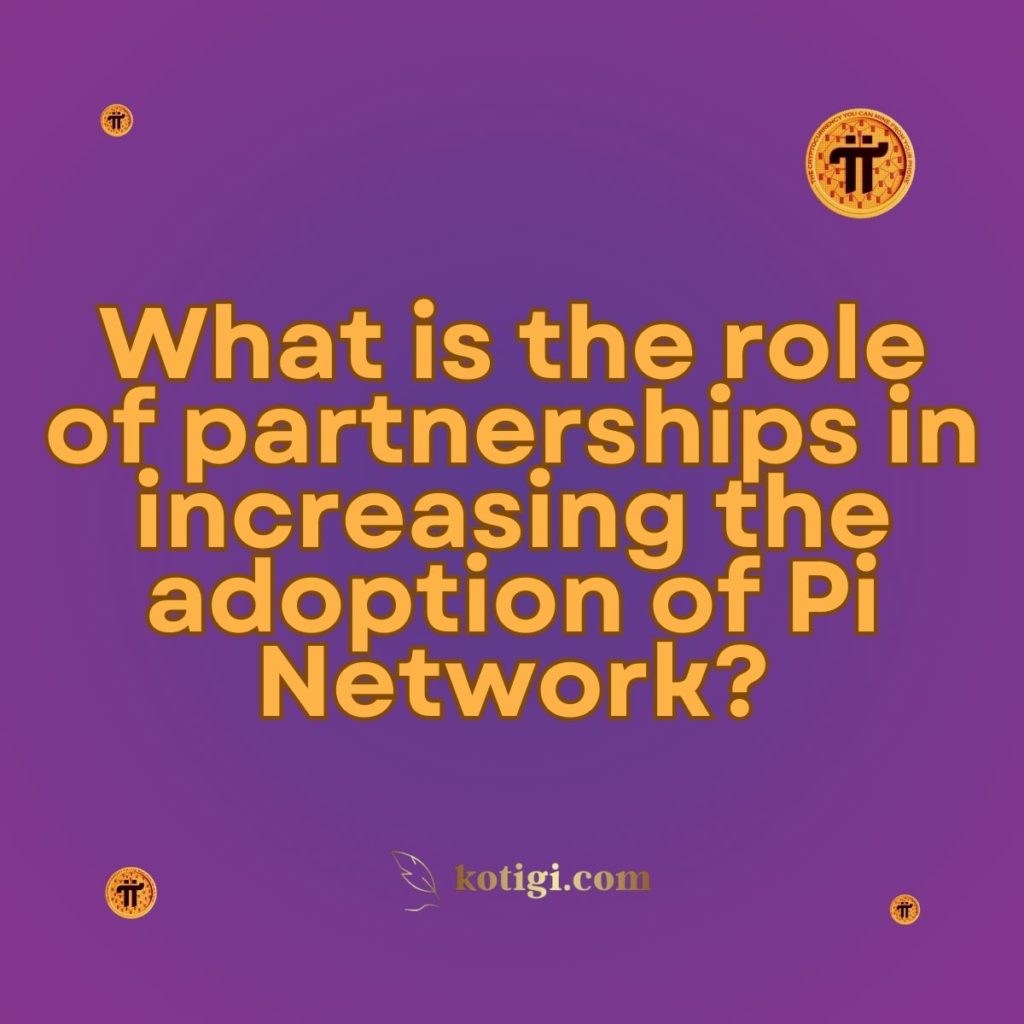
What is the role of partnerships in increasing the adoption of Pi Network?
Partnerships are key drivers in increasing Pi Network’s adoption, impacting technological advancements, merchant acceptance, community engagement, and global outreach. These alliances accelerate Pi’s utility and growth, making it a widely accepted and adopted cryptocurrency.
Introduction
Pi Network, a cryptocurrency that began with mobile mining, has grown significantly due to its robust community and innovative approach. However, a substantial part of its current and future adoption can be attributed to strategic partnerships. These collaborations enhance Pi Network’s technology, foster community engagement, integrate with merchants, and enable global expansion. This post explores the various roles partnerships play in increasing Pi Network’s adoption and highlights how these collaborations are essential for the long-term success and utility of Pi.
1. Enhancing Technological Infrastructure
For any cryptocurrency, the strength of its underlying technology is crucial. Pi Network’s technological infrastructure relies on key partnerships that ensure its growth, scalability, and security.
1.1 Collaboration with Blockchain Developers
One of the primary ways Pi Network enhances its technology is through partnerships with leading blockchain developers. These collaborations bring innovative solutions to the platform, ensuring that Pi remains cutting-edge and scalable as its user base grows.
1.2 Securing the Network
Cybersecurity is a growing concern in the cryptocurrency space. Pi Network’s partnerships with cybersecurity firms play a critical role in securing the network against potential threats. These efforts not only enhance the network’s security but also boost user trust.
1.3 Cloud Services for Scalability
Partnerships with cloud service providers help Pi Network manage its expanding user base. By leveraging cloud infrastructure, Pi ensures that the platform can handle increased traffic, data storage, and transaction processing, making the user experience seamless.
1.4 Continuous Technological Upgrades
Collaborative partnerships enable continuous upgrades to Pi Network’s technology. These partnerships ensure the network is always up to date with the latest advancements in blockchain technology, making Pi a competitive option in the cryptocurrency market.
1.5 Integration with Decentralized Technologies
In addition to scalability and security, Pi Network seeks to integrate with other decentralized technologies. By partnering with decentralized application (dApp) developers, Pi can create additional utilities for its users, promoting broader adoption.
2. Merchant Integration
For any cryptocurrency to gain mainstream acceptance, its usability in everyday transactions is critical. Partnerships with merchants help Pi Network become more integrated into the real-world economy.
2.1 Payment Gateways
One of the most effective ways Pi Network is increasing adoption is through partnerships with payment processors. These gateways allow merchants to accept Pi as a viable currency, thus creating more real-world use cases for Pi holders.
2.2 Building Merchant Networks
To facilitate merchant integration, Pi Network has been building partnerships with businesses, both online and offline, that accept Pi as a payment method. This expansion into various sectors encourages Pi holders to use their tokens, increasing adoption across industries.
2.3 Promoting Local Merchants
By collaborating with local businesses, Pi Network fosters a community-centric approach where users can spend Pi within their local economies. This grassroots adoption is vital for establishing Pi as a currency that people use in their daily lives.
2.4 Exclusive Merchant Offers
Partnerships that offer exclusive deals and promotions for users who pay with Pi can incentivize both merchants and customers to engage more actively with the network. This boosts transactional volume and enhances Pi’s utility.
3. Community Building and User Engagement
Engaging and expanding the community is another important aspect of Pi Network’s growth. Partnerships that focus on building a strong, active community drive user engagement and foster adoption.
3.1 Social Media Collaborations
Partnerships with influencers and online platforms play a huge role in spreading awareness about Pi Network. These collaborations help bring new users into the ecosystem while also educating them on the benefits of using Pi.
3.2 Ambassador Programs
To further grow the community, Pi Network has partnered with community ambassadors around the world. These ambassadors play a vital role in educating local populations about Pi, thus driving adoption in new regions.
3.3 Community Events and Meetups
Another strategy Pi Network uses to foster community engagement is through partnerships with event organizers to host meetups and conferences. These events provide opportunities for users to connect, share experiences, and learn about the latest updates, fostering a sense of belonging and commitment.
3.4 Collaborating with Educational Platforms
By partnering with educational platforms, Pi Network can create and distribute educational resources about blockchain and cryptocurrency. This helps users understand the broader implications of using Pi and encourages wider participation.
4. Global Expansion
Pi Network’s vision extends far beyond any single market or region. Strategic global partnerships are essential for expanding the network’s reach across borders.
4.1 International Business Collaborations
Global partnerships allow Pi Network to enter international markets, making Pi accessible to a broader audience. Collaborating with international businesses provides the foundation for Pi’s global reach and facilitates its entry into diverse economic regions.
4.2 Partnering in Emerging Markets
Pi Network sees significant potential in emerging markets, where traditional banking systems may not be as accessible. By partnering with local businesses and organizations in these regions, Pi is creating new opportunities for economic inclusion and digital transactions.
4.3 Multinational Partnerships
Through partnerships with multinational corporations, Pi Network can expand its presence across continents, tapping into global supply chains and cross-border payment networks. This helps boost adoption among international businesses and users.
4.4 Building Cross-Border Payment Solutions
Collaborations with financial technology (fintech) companies enable Pi Network to create cross-border payment solutions that make it easier for users in different countries to transact with one another. This increases the practical utility of Pi on a global scale.
5. Educational Collaborations
Education plays a pivotal role in increasing blockchain adoption. Pi Network’s partnerships in the educational sector help spread awareness and deepen understanding of its technology.
5.1 Collaborations with Universities
Partnering with universities to develop blockchain courses and research initiatives has helped Pi Network increase its credibility and attract talent. These educational collaborations not only boost awareness but also foster future developments in the ecosystem.
5.2 Blockchain Workshops and Seminars
Educational partnerships often involve organizing blockchain workshops and seminars for users and developers alike. These workshops are important for spreading knowledge about the technology behind Pi, increasing user adoption through understanding.
5.3 Offering Scholarships
Through partnerships with educational institutions, Pi Network can offer scholarships for students studying blockchain technology. This incentivizes learning while bringing new users into the Pi Network community.
6. Regulatory Compliance
Ensuring compliance with local and international regulations is essential for Pi Network’s growth. Regulatory partnerships enable Pi to operate within legal frameworks while expanding its reach.
6.1 Partnerships with Legal and Compliance Firms
Pi Network has built partnerships with legal firms and compliance specialists to ensure it operates within regulatory frameworks. This is vital for gaining the trust of both users and potential business partners.
6.2 Anti-Money Laundering (AML) and Know Your Customer (KYC) Compliance
By working with regulatory bodies and compliance firms, Pi Network ensures that it adheres to AML and KYC guidelines. This not only increases trust but also opens up new possibilities for broader adoption in regulated markets.
6.3 Collaborating with Global Regulatory Bodies
Partnering with global regulatory organizations helps Pi navigate the legal challenges that come with operating a global cryptocurrency. These collaborations pave the way for Pi’s entry into new markets and improve its chances of mainstream adoption.
7. Marketing and Outreach
Marketing plays a critical role in spreading the word about Pi Network, and partnerships in this area are essential for boosting visibility and driving user adoption.
7.1 Media Partnerships
Collaborating with media outlets helps Pi Network share its story with a larger audience. These partnerships are crucial for generating public interest and keeping users informed about the network’s developments.
7.2 Influencer Collaborations
Working with cryptocurrency influencers to promote Pi Network has proven effective in engaging potential users. These influencers reach out to their followers, educating them on the benefits of Pi and encouraging them to join the network.
7.3 Targeted Social Media Campaigns
In addition to influencer collaborations, Pi Network runs targeted social media campaigns in partnership with marketing firms. These campaigns help reach a broader demographic and ensure Pi’s message resonates with diverse user groups.
8. Innovation and Development
Partnerships that encourage innovation help Pi Network remain competitive in the cryptocurrency space by enabling continuous technological and developmental progress.
8.1 Developer Communities
Pi Network partners with developer communities to foster innovation and create decentralized applications (dApps) on its platform. These dApps increase Pi’s functionality and broaden its appeal to a wider audience.
8.2 Hackathons and Developer Grants
By organizing hackathons and offering developer grants, Pi Network encourages creative problem-solving. These initiatives attract talented developers and generate new ideas for expanding Pi’s ecosystem.
8.3 Supporting Open-Source Projects
Partnering with the open-source community allows Pi Network to benefit from collaborative development efforts. This openness helps enhance the platform’s technology and build trust within the cryptocurrency community.
Conclusion
Partnerships play a vital role in increasing the adoption of Pi Network. From enhancing technological infrastructure to driving merchant integration, community engagement, and global expansion, these collaborations are essential for Pi’s success. As Pi Network continues to grow, these partnerships will only become more critical in ensuring its widespread adoption and utility as a globally accepted cryptocurrency.
Key Takeaways
- Strategic partnerships with technology firms ensure Pi Network remains scalable, secure, and innovative.
- Merchant collaborations drive real-world use cases, enhancing Pi’s utility in everyday transactions.
- Community-building partnerships, including ambassador programs and social media collaborations, foster user engagement and expansion.
- Global partnerships enable Pi Network to tap into diverse markets, driving broader adoption.





